- This Michael Moore produced movie got so many things wrong about the clean energy movement.
- Its cherry-picked "scientific" facts are very misleading and don't paint the full picture.
- It also blames clean technology for numerous failures when the fault lies with poor policy and implementation.
This article was written by Ben Wehrman. It was originally published on his blog. It’s been republished here via strategic partnership.
—
FUD (Fear, Uncertainty, and Doubt): A disinformation strategy used to influence perception by disseminating negative and dubious or false information and a manifestation of the appeal to fear.
I. Intro
A few days ago, Michael Moore (a lifelong far-left activist and documentarian) went completely off the rails, shocking the world with the release of a film that utterly trashes the world’s transition to renewable energy.
As he was hoping, it caused an explosion of controversy, attention, and millions of clicks.
Like many other clean energy enthusiasts, I was stunned. But thanks to my experience working at Tesla as well as a few other solar companies across the USA, Australia, and New Zealand, it was pretty easy to spot the bullshit.
Here’s what you need to know.
II. What Planet of the Humans got wrong:
#1: Misrepresenting
The first major problem with Planet of the Humans is its misrepresentation of the clean energy movement. In short, the producers lump ALL non-fossil fuel energy sources as “renewables,” when in truth this is simply not the case.
Let’s categorize the movie’s main targets into their rightful places:
Clean energy
Solar
Wind
Geothermal
Electric Vehicles
NOT clean energy
Ethanol plants
Natural gas
Biomass
Biofuels
The second list may not pollute in a visually-obvious way like clouds of coal or oil spills, but make no mistake–they are NOT the long-term answer–the scientific community dismissed them from the clean energy conversation years ago.
So why does 75% of the movie focus on these “fake” renewables? Well, primarily because most of the filming was done before anyone knew any better (nearly a decade ago) but we’ll get to that later.
Let’s take a quick look a few of these, and why they’re so misrepresentative of clean energy.
Biofuels & Biomass
If it burns stuff, it ain’t clean. They’re a small and shrinking part of the global energy mix, and the environmental leaders that Planet of the Humans accused of supporting it have already changed their mind years ago.
The few video clips of rich businessmen (Richard Branson, Michael Bloomberg, Vinod Khosla) peddling these dirty alt-energies means nothing. They do not represent the clean energy movement.
Oh, and the claim that Germany gets more electricity from biomass than wind and solar? Flat out false! Here are the real numbers for 2019:
Biomass: 45.48 TWh
Wind: 127.23 TWh
Solar: 46.54 TWh
Did the filmmakers simply forget to google this?
Natural Gas
Again, a terrible example of what the Planet of the Humans claims to be in the bucket of “clean energy.” NG has been dismissed as a sneaky tentacle of fossil fuel for years, and basic research would tell you that it’s even worse than coal in some ways.
Thankfully, despite anti-renewables media repeatedly forcing it into the conversation, natural gas is clearly on the downtrend. According to the Federal Energy Regulatory Commission (FERC), wind and solar are both on track to decimate natural gas in new generating capacity over the next three years:
(Wind, 26,167 MW; Solar, 22,593 MW; Natural Gas, 21,822 MW).
No matter how hard humans try to come up with stupid ways to create energy and charge people for it, the sun will win. It’s just a matter of how quickly we embrace it.
Rather than exposing these fakers from the pack (which would be a great public service), the film doesn’t stop there–they also trash the real solutions like wind, solar, and electric vehicles. To do this, they cherry-pick a mixture of outdated, bottom-quality, and otherwise worst-case situations for each.
Wind
Featured in the film: A wind project that cut down a section of forest for placing wind turbines.
When in doubt, just show a montage of trees being cut down!
This is an extreme outlier for wind OR solar. The vast majority of these projects are constructed in large, wide-open areas with minimal environmental damage.
But alas, it’s more dramatic to show pictures of fires and destruction.
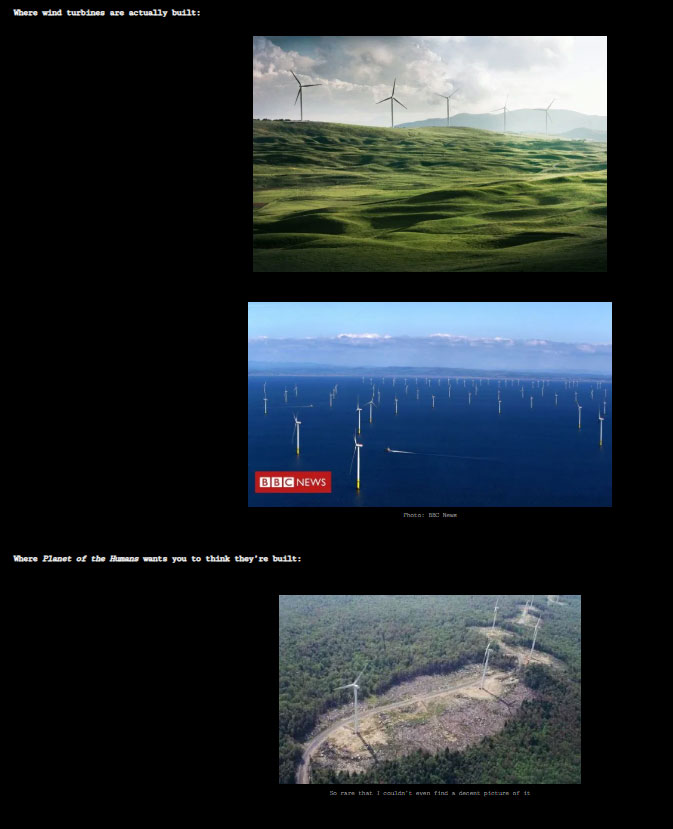
Solar
Featured in the film: An old, partially-decommissioned solar farm in the middle of nowhere.
Despite solar power growing at record pace across the globe, the filmmakers hunted down a single solar farm that contained some broken panels (which were likely in the process of being replaced, as the facility they visited IS still producing power). This didn’t stop them from declaring it a “solar dead zone,” and using it as fodder to paint the idea that the entire solar industry is in ruins.
Even if the featured project was “dead” as they claimed it to be, it should be clear that the problem had nothing to do with the actual solar technology.
As the neighborhood citizen they interviewed stated: locals, including her husband, had been working on that solar farm since “1983-1984.” Then later on, after a few badly-planned projects, many of the jobs were lost.
The problem should be clear: this wasn’t a solar problem, it was a mismanagement of human resources problem.
Thankfully, this is nowhere near the case for the overall solar industry. According to Scientific American, solar-powered electricity in the U.S. accounted for nearly 40% of all new generating capacity in 2019, and total installed photovoltaic (PV) power is expected to more than double by 2025.
(I personally believe this estimate will be blown out of the water once Tesla solar roofs hit the mainstream, but we’ll have to wait and see)
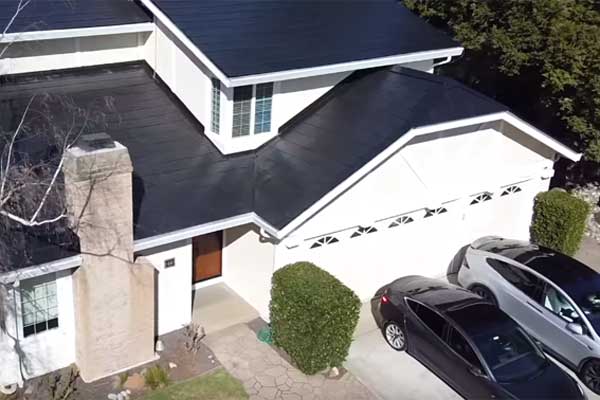
Tesla Solar Roof version 3 installed in San Ramon, CA.
Electric Vehicles
Every clean energy follower knows that while several EV companies are making fantastic strides, there’s a clear top dog in the race:
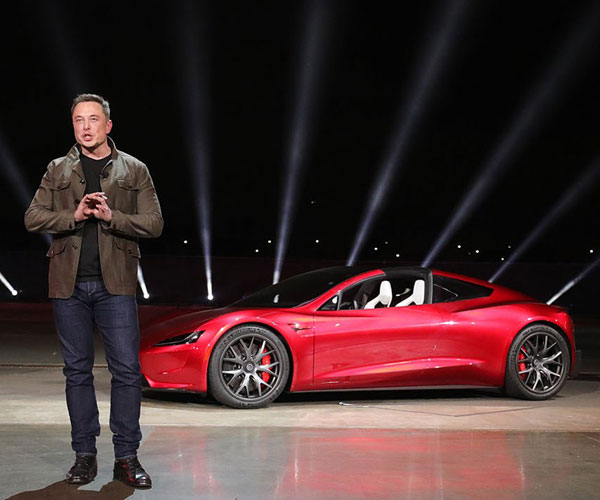
Elon Musk standing near a Tesla vehicle
So surely, if the filmmakers want to attack this industry, they’d have the balls to talk to Tesla directly, right?
Nope. Within the first few minutes of Planet of the Humans, they shove a microphone into the face of General Motors, and grill the poor marketing lady on the sustainability statistics of their bottom-tier EV. As expected, she talks herself into a knot.
Here’s why this is so laughable:
If you’ve been following the EV movement, you know that GM is attached at the hip to fossil fuels (AKA gasoline cars) since they literally LOSE MONEY with every EV they sell. They’re forced to release a few junk EVs here and there since certain markets have strict emissions laws, but they are deeply incentivized to continue selling pollution boxes for as long as possible.
This carries onto their employees–whose job security depends on that company’s gas car revenue to keep their payroll alive.
Legacy auto companies are doomed to go bankrupt either way (they’re getting demolished by Tesla) but that’s beyond the point.
The gist of it is this: The EV revolution is a death sentence for legacy auto companies (GM, Toyota, Ford, etc.) since they require fossil fuels to be profitable. To feature them in the film as a voice for EVs is like asking a salmon how they feel about the fishing industry.
#2: Short-sighted
In the previous section, we discussed how Planet of the Humans focuses on a mix of “fake” renewables that have long been dismissed by the scientific community, and misrepresentative examples from the true solutions like wind, solar, and EVs.
In doing this, Planet of the Humans also avoids all considerations of the future.
Here are a few examples of its blatant short-term messaging:
Today’s solar panels are inefficient.
They featured nothing but the shittiest of solar panel brands throughout the movie (not to mention being several years old, since filming reached as far back as at least 2012). Of course these old, start-up quality panels are inefficient! Not a peep about projects by solar leaders such as First Solar, Sunrun, Enphase, or Tesla, who are breaking solar efficiency records almost weekly.
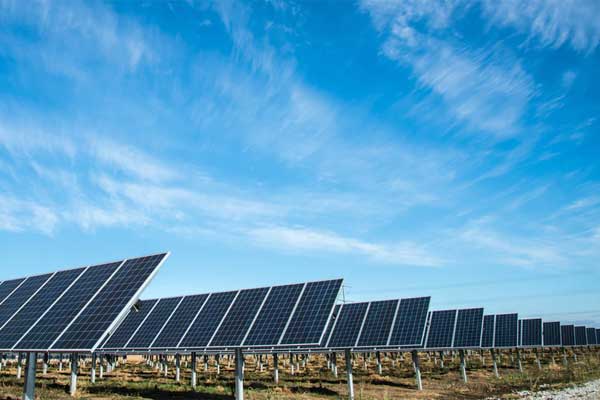
Solar panels by Lincoln Electric Systems, Lincoln Nebraska
Some solar panels are built to last only 10 years.
This is an actual quote from a random booth attendant at what appears to be a job fair. (Telling on the height of the bar required to make the final cut.)
What a shamefully uninformed statement to include in a documentary. Anyone that follows the solar industry knows that the market average is far above this level (20-30 years conservatively, and rising), so please Michael Moore, stop shoving microphones into the faces of confused teenagers that are working for their dad’s backyard solar business.
Isn’t solar just as bad as coal since it requires mining?
Let’s take a look at the interviewee that brought this bright idea to the table:
His name is Ozzie Zehner, and here are his credentials:
1. Author (book plug included)
2. Close friend of Michael Moore
3. Last but certainly not least, he’s the producer of the movie!
Theeeeere it is. That’s right, the filmmakers didn’t want to interview actual professionals in the clean energy space, so they interviewed each other! BRILLIANT!
Let’s unpack this vintage “solar vs. coal” FUD:
1. Innovation is leading to rapidly-decreasing material requirements in solar and battery technology. (For example, the level of cobalt-mining required for Tesla’s batteries is dropping over time, and will eventually be zero.)
2. Fossil fuels require MORE of these rare earth metals to begin with, and simply BURN IT UP to create power. *Poof*. Pumped right into the air for us all to breathe.
Which of these sounds like a better solution to you?
One more time–clean energy products such as solar panels and batteries use their materials to build energy assets that:
1. Produce power for decades
2. Upon expiration can be recycled into new raw materials
3. Can then be used to build NEW solar panels & batteries, thus creating a closed-loop process that is essentially zero-pollution and zero-waste.
Tesla-specific attacks
As I touched on earlier, Planet of the Humans avoids mentioning Tesla as much as possible (smartly so, since they’d be able to dismantle nearly every FUD point made).
However, they do manage to squeeze in about 20 seconds of pebble throws:
The “mining for resources is bad” argument, while completely ignoring:
1. Increasing reusability of materials
2. Increasing recyclability of materials.
3. Decreasing requirement for mining, as total materials in circulation increases.
If the Gigafactory has solar panels, why is it connected to the grid?
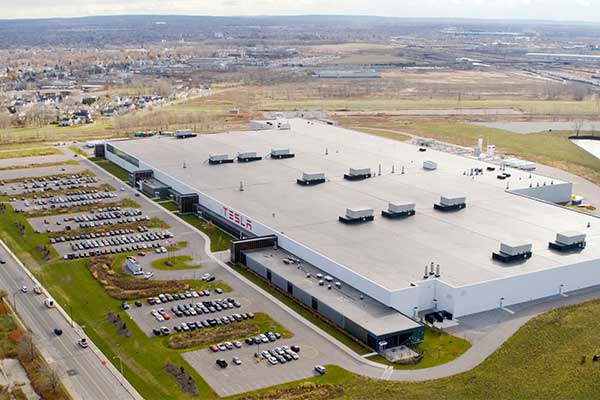
Gigafactory 2 located in New York is a photovoltaic cell factory leased by Tesla subsidiary SolarCity in Buffalo, New York. The factory, owned by the State of New York, was built on brownfield land remediated from a former steel mill. Construction of the factory started in 2014 and was completed in 2016–17 (Bloomberg).
Because power generation is not one-way. The renewable energy mix that Tesla’s gigafactories use aren’t always required for the factory’s processes, so during downtimes (like during the pandemic lockdown, for example) this energy can be given back to the grid, thus reducing the need for fossil fuels even further.
This is also being done by Tesla solar roof customers every day! When they don’t need all the energy they’re producing, they can simply click a button, and sell ($$$) their excess energy back to the grid. The more solar owners that participate in this power grid takeover the better, since expensive, resource-intensive methods like coal-burning and natural gas simply cannot compete with the sun. (This book taught me a great deal about this “electricity bidding” process, I highly recommend it.)
This new idea of a two-way power movement will soon become a game-changer in the energy industry, and I’d bet my lunch Michael Moore has never even heard of it.
Let’s wrap this section up in as simple of a way as possible:
Whenever humans face an unprecedented challenge that requires a long-term mindset, they fall into 1 of 2 camps:
1. “These wind turbines and solar panels aren’t perfect right now, so they’ll never work!”
2. “These wind turbines and solar panels have problems, so let’s improve them, and take advantage of the opportunity to make our entire energy system sun & wind-powered instead of pollution-powered!”
This film takes the easy route: #1. AKA the low-hanging fruit of FUD, along with the rest of the sheep-minded thinkers of the world that will cling onto their Exxon stocks until the day they die.
We’ll see how that goes for them …
#3: Horrible interview sourcing
This misrepresentation and short-sightedness of the clean energy movement can be quickly traced to the fact that the filmmakers don’t interview anyone who is even remotely qualified to speak on the matter.
Since we’re on lockdown and I have nothing better to do, I went back to conduct a start-to-finish tally of every interviewee whose lines were included in the final cut of the film:
25 Festival attendees, group leaders, & event organizers
20 Random people off the street
13 Job fair booth attendants & marketers (or “industry insiders” as the movie calls them)
8 Hikers & walking-tour guides
5 Utility, construction, & logging employees
3 Psychologists
2 College kids
2 Authors (book plugs included)
1 Ecologist
1 Zookeeper
That’s it! The complete list of every person that was interviewed in the movie.
Notice anything missing here?
How about SCIENTISTS? ENGINEERS? Or literally ANYONE with a hint of credibility in the clean energy space that the entire movie focuses on?
They’re nowhere to be found, of course, since they’d easily dismantle Planet of the Humans’ ongoing message that all environmentalists are bumbling idiots.
Can you imagine Michael Moore trying to debate Elon Musk on sustainable energy? It’d be a bloodbath.
#4: Miscellaneous skepticism, lies, and other BS
What happens when you disclude the voices of scientists, engineers, and any other (sorry but) smart people?
You end up reaching into the hat of stone-aged FUD arguments and asking them to college students & street hippies until you have enough “GOTCHA” moments to make a movie.
Solar? But what if the sun stops shining?
If you read my recent blog post about Tesla’s closed-loop energy system, you’ll be able to answer this in a heartbeat. Batteries.
But batteries are bad because we have to mine things to create them!
Another point that I’ve already explained in-depth, but we can do this all day if we have to:
1. Battery mining is far less resource-intensive than fossil fuels to begin (and decreasing, while fossil fuels are increasing)
2. The final product can be reused thousands of times, as opposed to fossil fuels, which are simply burned into the air we breathe
3. Becoming increasingly reusable AND recyclable as companies like Tesla continue to innovate their supply chains
Next.
But we don’t have enough batteries to store all the energy!
Planet of the Humans features one of the dumbest pie charts I’ve ever seen, showing how we don’t currently have enough battery capacity to support 100% of the planet’s renewable energy generation.

Translation: The growth potential of battery storage is so mind-bogglingly large that we haven’t even scratched the surface on it yet!
This is precisely why so many people, myself included, are so excited about the possibilities that this innovation will bring.
In a couple years, some [batteries] begin to degrade, and need to be replaced.
Quote credit: Another clueless booth attendant at a job fair
This is absolutely untrue, and is becoming increasingly less so as battery technology improves. Do research.
Aren’t EVs just powered by coal?
Ah, an ancient relic in the FUD history books!
Even if this were true, it would be far more efficient to consolidate emissions to a single remote location, rather than have millions of pollution boxes running around clogging up every road & city with shit air.
Thankfully, we don’t have to make this argument, since the grid is rapidly shifting toward renewable energy sources (solar, wind, geothermal, etc.). Thich will lead to an increasingly-clean energy mix over time, so emissions don’t happen anywhere.
BONUS: This adoption will continue to accelerate as the world wakes up to the fact that renewables don’t just remove pollution from our lives, they save us TONS of money. (The only reason coal and oil companies are still alive today is because of taxpayer subsidies footing their enormous bill)
And if you’re worried about how much space these renewable energy projects will take up …
Solar fields will take up all of our land!
Bullshit. At today’s PV efficiency (i.e. the worst it’ll ever be), a single 100-mile x 100-mile solar field in the middle of the desert would be enough to power the entire USA, and part of Canada!
And doesn’t even take into account:
1. As PV efficiency continues to improve, the surface area required will decrease substantially
2. All the home solar, wind turbines, geothermal plants, and other renewable energy sources are picking up an increasing amount of the slack.
Did I mention that in the future, every residential, commercial, and industrial building’s roof will become an automatic pollution-free energy generator, with no additional panels required?

The newest solar roof is made with tempered glass; collectively, the product consists of both solar and nonsolar tiles. The estimated price of a 2,000-square-foot roof is $33,950, according to Tesla.
Michael Moore forgot to google that one. Oops!
#5: It’s aimless
As the credits of Planet of the Humans roll, I dare you to answer one simple question:
What actual solutions or new ideas does Planet of the Humans bring to the table?
I’ll wait because after watching it 4 times to research for this post, the only thing that comes close is “we need to limit overpopulation and overconsumption.” To that I say: absolutely! We can all agree that this is important, but why not make the future and the present better at the same time? You don’t have to pick just one!
#6: Follow-up fail
Whenever a director releases a 180-degree shocker from their usual theme, the public will want answers. (*Raises hand.*)
Less than 24-hours after the release of Planet of the Humans, Michael Moore made an appearance on Late Night with Stephen Colbert.
What can we glean from it?
He admits the movie was mostly filmed several years ago (0:19).
This is fairly obvious to anyone who has followed the clean energy movement for the past few years. The rare statistics that are brought up in the movie are ancient (according to the Director, Jeff Gibbs’ bio, filming began at least as far back as 2012, probably earlier). This is a lifetime in the fast-paced industry of clean energy.
He backpedals on the film’s clear theme of hopelessness: “It’s not depressing” (2:23) and “I refuse to accept that it’s too late” (1:17)
Really?
See point #5–you quite clearly contradicted these statements thoroughly in the film.
Still, nothing productive to add to the conversation
Unfortunately, aside from spending most of the interview regurgitating the standard “earth is dead” spiel (and Colbert visibly holding back laughter as he tries to decipher the nonsense), Moore gives us nothing more than a growing list of examples why he’s grossly unqualified to shit-talk the environmental movement. Here’s a fun one:
(1:03): “The parts per million of carbon in the atmosphere has passed 350, and is at 410 now.”
(1:44): “We cannot solar panel and windmill our way out of this.”
Pardon? As that movie, you released less than 24 hours ago stated, fossil fuels account for basically all of that pollution you just mentioned.
And your solution is that we:
1. Don’t replace coal plants with the things that don’t pollute (solar, wind) and
2. Don’t replace gasoline vehicles (#1 source of emissions on earth) with sun-powered ones?
I’m sorry, but this is delusional.
III. What Planet of the Humans got right
It should be pretty clear by now that this film is a disaster in most ways that matter.
BUT…credit must be given where it’s due. Here are the points from the film that deserve acknowledgment.
Stop telling lies to please the crowd.
The Earth Day festival scene was unfortunate.
The event organizers straight-up lied about powering the festival on 100% solar power, which outlines a point that must be made: Even the good guys will finesse the truth sometimes, and we need to hold them accountable just like everyone else.
I hope that future event-runners take note, and think twice before pulling sunshine out of their ass to please their followers.
We need to keep our bullshit radar on alert during the transition away from fossil fuels
We all know how far big corporations will go to massage warm & fuzzy buzzwords like “sustainable,” “eco,” and “green.” We see this shit everywhere.
Just yesterday, in the city I’m currently living (Wellington, New Zealand), I saw a taxi parked on the street from a company called “Green Cabs.” It had the full shebang: full green paint job, decals of flowers and sunshine, and a logo of smiling planet earth.
Only problem? It was a f%$#ing ICE car!!
Another example comes from the same Earth Day scene mentioned above; the sponsorship list was packed with embarrassingly non-sustainable companies attempting to force their way into the “green” club (specifically Toyota, Caterpillar, and CitiBank).
Now, while I don’t personally believe that taking free money is an automatic sin, we all need to be smart, and not fall in love with every corporation that slaps a “sustainability” page onto their website.
We all need to learn how to think critically, and stop mindlessly following what the media and corporations want us to think. This means seeking out our own information, and following independent news sources like these that aren’t being bribed by multi-billion dollar companies behind closed doors.
Environmental groups need to take a firm, loophole-free stand against biomass, biofuels, natural gas, and all the other alt-energies that are clearly not long-term solutions.
This film definitely exposed some shady fine-print on how Sierra Club, and similar environmental organizations have allowed dirty alt-energies to tiptoe into the renewables definition.
I forgive them–the world is changing fast, and it can be hard to keep up, even for those at the top. But as the scientific community, as well as the majority of environmental activists now know, burning ANYTHING (trees included) is not the answer!
Green Investment Funds” need to step their shit up.
There are so many investment options out there that tout an environmental mindfulness, when in reality, they usually just hold a couple of green stocks along with a massive amount of filler trash. (Al Gore has Coca Cola, the largest plastic polluter on earth, in his “green” portfolio….bad look, dude.)
This is why I only invest in companies or ETFs (exchange-traded funds) that I have a strong understanding of.
If they’re not building the future I believe in, I’m not investing in them! It’s as simple as that.
IV. Planet of the Humans: Conclusion
While Planet of the Humans contains a few points worth taking note, they are completely buried by misinformation, short-sightedness, and complete lack of scientific facts.
Whether it’s happening fast enough to satisfy Michael Moore or not, here’s the truth:
Solar efficiency is improving
Wind efficiency is improving
Battery storage & recyclability is improving
Electric Vehicle efficiency is improving
The people of earth are waking up
We’re not even scratching the surface of the benefits we’ll see from these innovations, but unfortunately, the low-hanging fruit of willful ignorance will continue to attract the sheep of the world.
So, what do us clean energy enthusiasts do from here?
The same thing we’ve always done: Accept the fact that what we’re doing is unprecedented, and the majority of humans are too short-sighted to understand. Sure, it may hurt a little more when someone we thought was on our side takes a stance against us, but in the end, it’s all the same noise.
The movement toward a cleaner planet is not a popularity contest. I think I can speak for the entire clean energy community when I say: we’ve given up on trying to make everyone happy long ago. As long as billions of dollars stand to be lost from those profiting on the status quo, it’s simply impossible. This includes media productions like Planet of the Humans who choose to chase clicks and Twitter followers by stirring up tribalism.
Thanks for the added motivation Mr. Moore, now move aside.
We’ve got work to do.
—
If you would like to watch the movie, here you go!
 I’m obsessed with living the most epic life possible and spreading excitement on companies that are making the world a better place. Currently backpacking across New Zealand, and building a personal blog where I can share what I’ve learned on this crazy adventure ➡ Twitter
I’m obsessed with living the most epic life possible and spreading excitement on companies that are making the world a better place. Currently backpacking across New Zealand, and building a personal blog where I can share what I’ve learned on this crazy adventure ➡ Twitter 






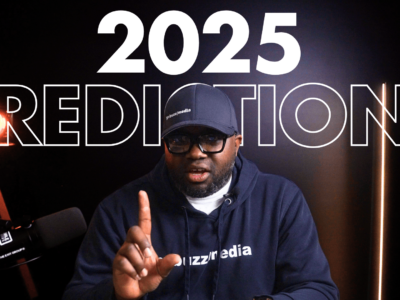

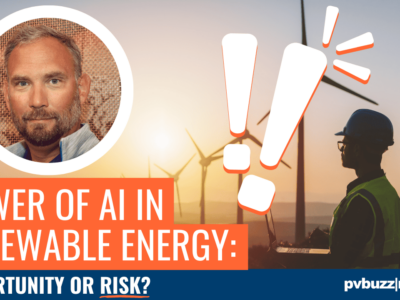


Comments